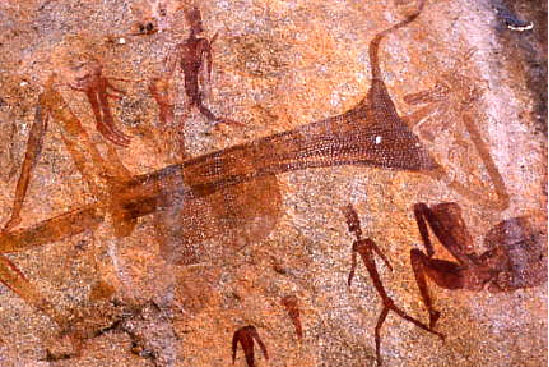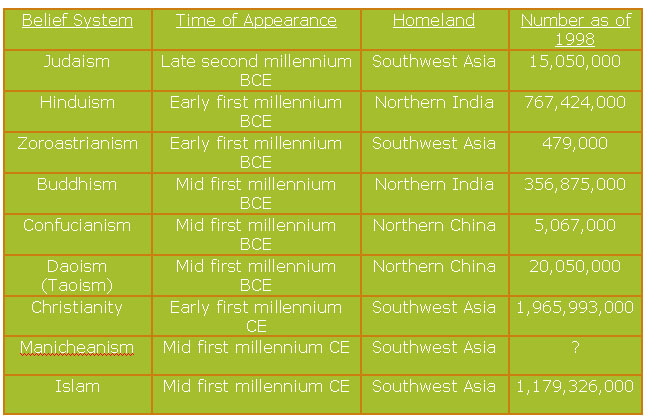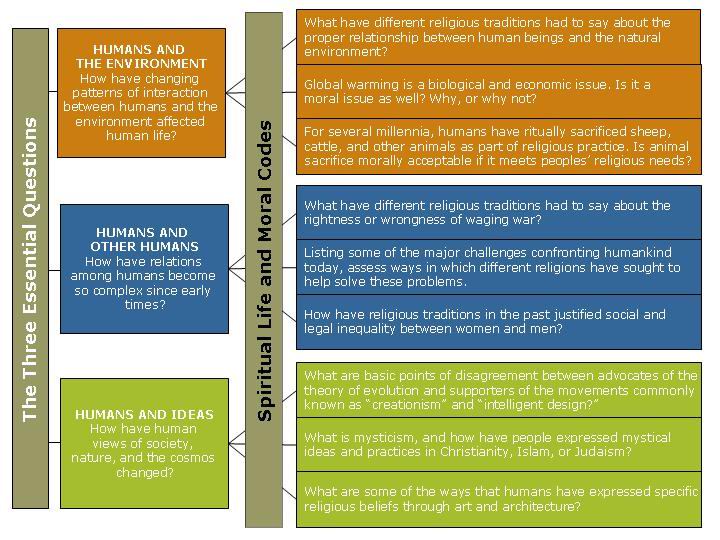Home > Key Themes > Seven
Key
Theme 7: Spiritual Life and Moral Codes |
|
|
Are morality and spirituality unique to human beings? How
has human spirituality changed in the course of history? How
have changing ideas of morality and spirituality shaped history?
The word spirituality refers to human awareness of a transcendental
state of being, one that is beyond the material world of everyday
life. It may mean belief in a supreme creator, in an afterlife,
or in the existence of mysterious spirits and magical forces.
Our sense of spirituality shapes how we think of the world
and our place in it. It also shapes our sense of morality,
that is, the way in which we recognize differences between
right and wrong. Spirituality has been a powerful force in
human history.
Do animals have a sense of spirituality or morality? All
animals have to learn that some behaviors work well and others
do not. A young deer that strays too far from its herd may
be “punished” by being killed. Those who learn
these rules of behavior survive. Those who do not learn them
may die.
We have no evidence, however, that animals think in moral
terms, no sense that they are aware of doing “good”
things or “bad” things. Being aware of morality,
like being aware of identity (Key
Theme 5), appears to be uniquely human. Only we humans
have language, which allows us to think about the rightness
or wrongness of our behavior. The same is probably true of
spirituality. Symbolic language allows us to express and share
information, not just about what is in front of us, but also
about things that we cannot see with our eyes or hear with
our ears. Language lets us think and talk about God, angels,
saints, demons, fairies, heaven, and hell. Only humans, it
seems, can imagine a spiritual realm.
As far as we know, all human communities have had ideas of
a spiritual realm and of rules for right and wrong behavior.
Different communities, however, have thought about those things
in an astonishing variety of ways. People have often fought,
killed, or died to put forth or defend their own ideas of
spirituality and morality. A belief or practice that one community
considers normal may seem totally unacceptable to another.
For example, in some communities people have traditionally
regarded public nudity as normal. In others, they have seen it
as shocking and offensive.
What can we know of the spiritual life of our distant ancestors
in paleolithic times? Archaeologists have found many objects
that look as if they had spiritual meaning to those who created
them. Fifteen thousand years ago, people in southern Europe
took the trouble to crawl far back into the dark reaches of
a cave to carve clay statuettes of bison that hardly anyone
was ever likely to see. We do not know why they did this but
certainly not merely to amuse themselves or to make "art
for art's sake." What about cave paintings that show
hunters stalking animals? Were these works possibly designed
to cast a spell over animal prey? One cave painting includes
the picture of a man who looks to modern eyes like a priest
or wizard. We do not really know if he was or not. The problem
is that we know so little about the wider social or cultural
contexts in which works like these were produced and used.
We do have some ideas, however. Anthropologists have studied
the spiritual beliefs of small, relatively isolated communities
that exist today. Scholars of paleolithic history base many
of their ideas about early human thought and behavior on such
studies. In many of these communities there may be no clear
borderline between the human and spiritual worlds. One feature
that seems to appear in all small-scale communities is animism.
This is the belief that the world is full of spirits and that
to survive one must coexist and communicate with them. One
must pray to them, bargain with them, and even try to ally
with them in disputes with human or non-human enemies.
The community may regard natural objects and forces, such
as rain, wind, thunder, trees, the sun, the moon, and stars
as members of a huge and varied family. People, however, may
not always think of spirits as more powerful or more moral
than humans. Spirits may be like family members. Some are
good and helpful, and some are bad, fickle, dangerous, or
stupid.
In some parts of the world societies have totemic beliefs,
that is, ideas about close spiritual ties between families
or clans and particular animals. The members of a “jaguar
clan,” for example, might forbid killing jaguars because
of the belief that these animals are in some sense also part
of the extended family.
How did people contact the spirit world? They might hear
spirits in a thunderstorm, or they might make contact through
dreams or rituals. Religious ceremonies might involve dancing,
chanting, or taking mind-altering drugs to induce a trance-like
state and a feeling of “crossing over” to the
spiritual realm. Frequently, communities looked for help from
individuals believed to have special gifts for communicating
with the spirits. In Siberia and some other parts of the world,
such specialists have been known as shamans. These are women
or men who have the power to go into a trance. In that state
they may “fly” to the spirit realm to talk, fight,
or plead with spirits—even to marry them. Upon returning
to the human world, shamans tell other people what happened.
Their pronouncements may have a powerful effect on people,
curing their diseases, cursing them, driving them to war with
their neighbors, or encouraging them to make peace. A shaman
could be an extremely powerful man or woman in a community.

Hunting and foraging
people painted this rock art in Zimbabwe in Southern Africa
about 2,000 years ago.
The scene depicts a
ceremonial dance whose purpose may have been to animate the
life force.
The large figure in the center, very likely wearing an antelope
mask, is lying down
and perhaps in a state of trance, or altered consciousness.
“ Diana’s Vow" site, Manicaland, Zimbabwe
R. Dunn
In small-scale societies, most spirits were
local, and people identified strongly with particular ones.
After about 12,000 BCE, however, larger-scale societies began
to appear. When that happened, people’s sense of spirituality
also changed. As communities became larger and more powerful,
their gods, too, became more potent and awe-inspiring. These
deities were often venerated beyond the local community.
Priests and rulers began to take on the power that shamans
once exercised. Rulers of city-states and kingdoms that existed
5,000 or 6,000 years ago often claimed spiritual power and
identified themselves with particular gods. In Sumer in lower
Mesopotamia (the Tigris-Euphrates River valley), each city
had its own major deity, which people represented in images
of stone or wood. For example, in the city of Uruk the goddess
of love, known as Inanna, inhabited the “white temple.”
This building stood atop a ziggurat, or stepped, pyramid-shaped
structure, which dominated the whole town.
In Sumer every urban temple had its religious leaders, or
priests, who had the job of pleasing the gods in endless rituals,
festivals, and sacrifices. People dedicated all their labor
to the service of the city’s gods. Therefore, the priests
claimed the right to command the population and economy, ruling
the city as the top social class. Religious teachings supported
the right of the city-state’s rulers to accumulate wealth
and wield power. Priests instructed ordinary people that,
if they wished to receive the blessing of the gods, they should
obey their rulers. The priests might try to dull people’s
willingness to protest against abuse and exploitation by threatening
them with the wrath of the gods or by promising them a better
life in the afterworld if they remained obedient.
In the third millennium BCE, when bigger states began to
appear, rulers almost always associated themselves with the
most powerful deities. In ancient Egypt or the later Roman
empire, for example, rulers claimed to be not only the deputies
of gods but deities in their own right. In the ancient Mediterranean
region and other places, people thought of their numerous
gods and goddesses as part of a pantheon, or “household”
of deities that controlled the universe as one big and sometimes
quarreling family. Stories about the gods were at the heart
of oral and literary traditions, and children learned about
duties and obligations, right and wrong behavior, from the
examples that gods and goddesses set.
In Afroeurasia in the middle centuries of the first millennium
BCE, belief systems began to appear that eventually became
world religions. These systems focused on a single supreme
god or cosmic, creative power. They also appealed to people
of differing languages and cultural traditions, not just the
members of a single city or local area. Most of these systems,
though not all, were “universalist” in that they
preached their message to whomever would listen, not just
to particular groups.
The major universalist religions to appear so far—all
of them by the seventh century CE—have been Hinduism,
Zoroastrianism, Buddhism, Daoism, Christianity, Manicheanism, and Islam. Among these,
Hinduism has remained closely associated with South Asian and,
to some extent, Southeast Asian societies. People have practiced
Daoism mainly in China. Confucianism also emerged in the mid
first millennium BCE, but as a belief system it has emphasized
moral and ethical behavior much more than spiritual doctrines.
Also, it has remained firmly linked to East Asian societies,
especially Chinese. Judaism, which took shape as a distinctive
belief system in the first millennium BCE, shared its monotheism,
or belief in one God, with Christianity and Islam. Jews, however,
did not take up a universalist mission but rather have transmitted
their faith mainly within the community believed to descend
from the early Hebrews.
Today, more than 70 per cent of the world’s population
identifies at least nominally with Buddhism, Christianity,
Islam, or Hinduism. In the past millennium, however, Manicheanism
has faded from global view, and Zoroastrians (called Parsis
today) number fewer than 500,000.

Table data from Ninian Smart,
ed., Atlas of the World’s Religions
(Oxford: Oxford University Press, 1999), 13.
All the world religions embrace varying beliefs,
practices, and sects. None is homogeneous or uniform. For
example, in Islam, Sunnism and Shi’ism constitute two
major branches with somewhat differing beliefs. In fact, the
Shi’ite tradition has several branches of its own. In
the Christian tradition Roman Catholics, Greek Orthodox Catholics,
Protestants, and other groups all share basic monotheism but
with numerous differences in doctrine, ritual, and practice.
Most major religious traditions also incorporate two important
dimensions. One of them involves people joining together for
public worship, communal prayer or ritual, scriptural study,
and mutual moral and social support. The other, which in some
traditions is characterized as mysticism, is concerned with
the individual’s search for knowledge of God, union
with the divine, transcendent experience, healing, and salvation.
For millions of people, religious experience may involve both
of these dimensions.
A final point about the varieties of religious experience
is that people in many parts of the world, and in rural areas
more than in cities, have professed one of the major religions
but assimilated older animist beliefs into it. For example,
a Christian community might honor a local saint who is a Christianized
version of an ancient god or spirit. For another example,
Muslims in some places wear a little box around their neck
with a piece of paper in it carrying an inscription from the
Qur’an. They display this charm, or amulet to ward off
evil, even though Muslim scripture does not condone such a
practice.

The architecture of Christian churches
varies greatly depending on the denomination and the region.
On the left is a Methodist chapel in Wales. On the right
is ancient Greek Orthodox church in Istanbul, Turkey.
R. Dunn
Today, many people argue that modern science
presents a powerful challenge to religion because it offers
explanations of nature, the cosmos, and human origins that
require no reference to God or any other manifestation of
spiritual power. Also, the material evidence that science
presents to support its description of the natural and physical
universe has continued to pile up, especially during the
past century. Few doubt that science, technology, and medicine
have benefited humankind in countless ways. For some people,
however, science and religion start from such contradictory
premises that they cannot be reconciled. This perceived
contradiction may even be a source of profound bewilderment
or dismay. Other people, however, find no trouble accepting
the propositions of modern science while at the same time
expressing faith in a transcendent creative power.
Principles and standards of ethical behavior
are as important to peace, order, and social cooperation
in the world as they have ever been. Science, however, has
very little to tell us about ethics. Also, persistent poverty,
environmental degradation, epidemic disease, and crime have
defied the best efforts of humanity’s scientific imagination.
Amid the distresses and dangers of our contemporary era,
people have sought not only communal ties to one another
but also moral and spiritual certainties. Spiritual quests
and ethical questions continue to be a vital part of human
cultural
Why Do We Need to Understand this Key
Theme?
-
For most of human history, spiritual
ideas have been at the core of how humans understand and
explain the workings of the natural, physical, and social
world. No wonder that people have stood up, and sometimes
died, for their religious principles, or that societies
have built their sense of unity and identity around their
spiritual traditions. How people explain the world and
find meaning in it shape their hopes, fears, and behavior
toward one another. Young people who struggle today with
spiritual questions and uncertainties should understand
how and why these yearnings have always been among the
most powerful shapers of the human past.
- Human beings learned long ago that peace, order, and cooperation
within social groups, whether they be families, foraging
bands, business partnerships, or nation-states, depend in
the long run on guiding principles, standards, and rules
of moral behavior. Systems of morality and ethics vary around
the world, but all of them are founded on ideals of social
harmony and trust. Moreover, successful collective learning
among human communities requires forthrightness, honesty,
and trust between both individuals and groups. Belief systems
embody the shared moral and ethical expectations that allow
humans to get along in peace and to learn systematically
from one another.

Landscape and Closeup Teaching Units that Emphasize
Key Theme 7:
[In Development]
|
